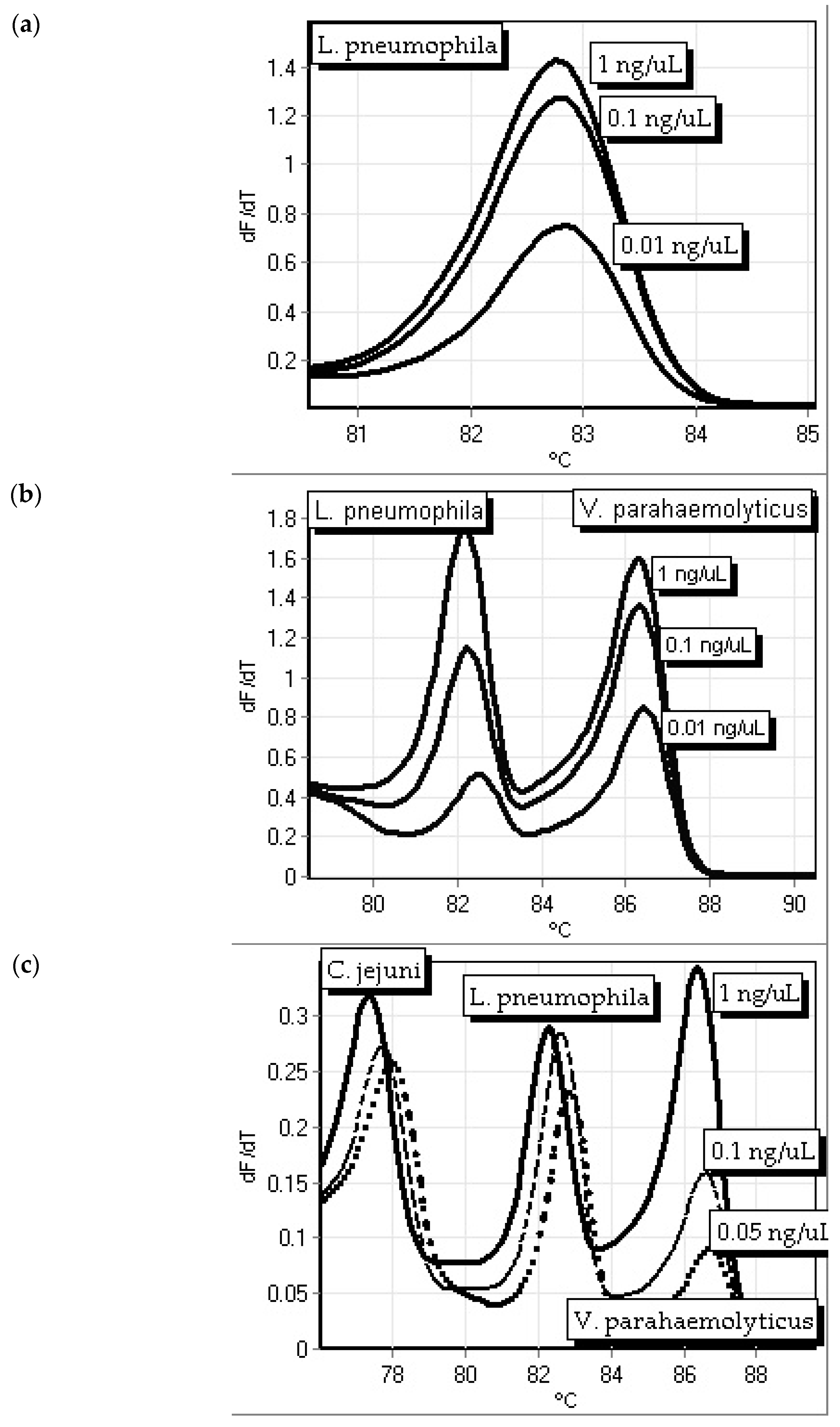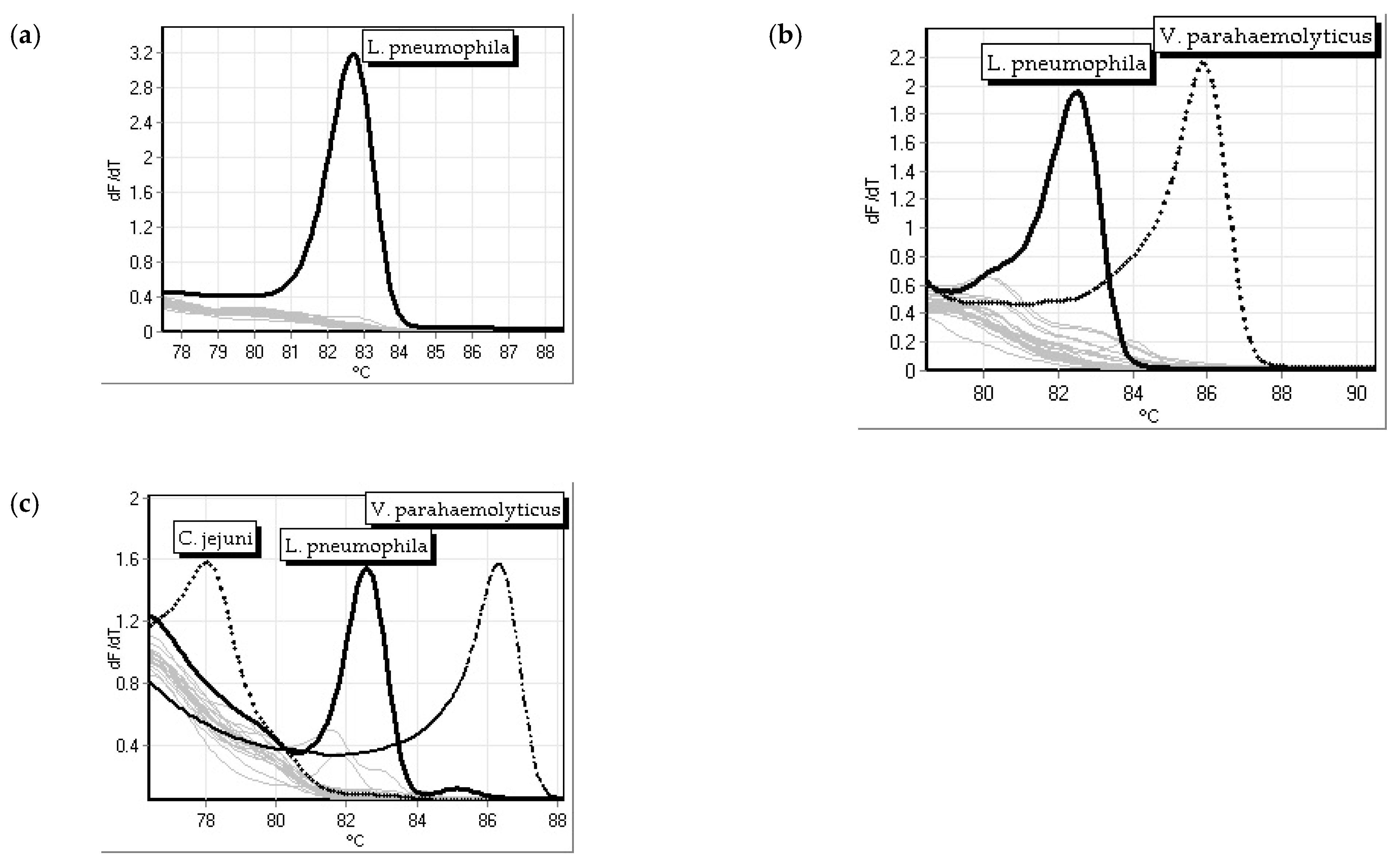Development of Polymerase Chain Reaction–High-Resolution Melt Assay for Waterborne Pathogens Legionella pneumophila, Vibrio parahaemolyticus, and Camplobacter jejuni
Abstract
:1. Introduction
2. Materials and Methods
2.1. Bacterial Strains
2.2. PCR Primers
2.3. PCR Reaction Conditions and HRM Analysis
2.4. Sizing Using Agarose Gel Electrophoresis
3. Results
3.1. Repeatability Testing for the Singleplex and Multiplex Assays
3.2. Confirmation of the Amplicons
3.3. Sensitivity Testing
3.4. Specificity Testing
4. Discussion
5. Conclusions
Author Contributions
Funding
Data Availability Statement
Conflicts of Interest
References
- Van Heijnsbergen, E.; de Roda Husman, A.M.; Lodder, W.J.; Bouwknegt, M.; Docters van Leeuwen, A.E.; Bruin, J.P.; Euser, S.M.; den Boer, J.W.; Schalk, J.A.C. Viable Legionella pneumophila bacteria in natural soil and rainwater puddles. J. Appl. Microbiol. 2014, 117, 882–890. [Google Scholar] [CrossRef] [PubMed]
- Sawczyn-Domańska, A. Detection of Legionella spp. and occurrence of virulence genes: Lvh, rtxA and enhC in water samples from artificial water systems. Ann. Agric. Environ. Med. 2021, 28, 617–620. [Google Scholar] [CrossRef]
- Chambers, S.T.; Slow, S.; Scott-Thomas, A.; Murdoch, D.R. Legionellosis caused by non-legionella pneumophila species, with a focus on legionella longbeachae. Microorganisms 2021, 9, 291. [Google Scholar] [CrossRef]
- Loh, C.H.; Soni, R. Exposure to potting soils and compost material as potential sources of legionella pneumophilia in Australia. Respir. Med. Case. Rep. 2020, 31, 101156. [Google Scholar] [CrossRef]
- Alshae, L.J.; Flood, M.; Rose, J.B. Enumeration and characterization of five pathogenic Legionella species from large research and educational buildings. Environ. Sci. Water Res. Technol. 2021, 7, 321–334. [Google Scholar]
- Steffan, J.J.; Derby, J.A.; Brevik, E.C. Soil pathogens that may potentially cause pandemics, including severe acute respiratory syndrome (SARS) coronaviruses. Curr. Opin. Environ. Sci. Health 2020, 17, 35–40. [Google Scholar] [CrossRef]
- Chirico, F.; Sacco, A.; Bragazzi, N.L.; Magnavita, N. Can Air-Conditioning Systems Contribute to the Spread of SARS/MERS/COVID-19 Infection? Insights from a Rapid Review of the Literature. Int. J. Environ. Res. Public Health 2020, 17, 6052. [Google Scholar] [CrossRef] [PubMed]
- Heine, H.; Rietschel, E.T.; Ulmer, A.J. The biology of endotoxin. Mol. Biotechnol. 2001, 19, 279–296. [Google Scholar]
- Legionella Surveillance and Trends|Legionella|CDC. Available online: https://www.cdc.gov/legionella/php/surveillance/?CDC_AAref_Val=https://www.cdc.gov/legionella/health-depts/surv-reporting/surveillance-reports.html (accessed on 13 June 2024).
- Correia, A.M.; Ferreira, J.S.; Borges, V.; Nunes, A.; Gomes, B.; Capucho, R.; Gonçalves, J.; Antunes, D.M.; Almeida, S.; Mendes, A.; et al. Probable person-to-person transmission of legionnaires’ disease. N. Engl. J. Med. 2016, 374, 497–498. [Google Scholar] [CrossRef]
- Legionnaires’ Disease Surveillance Summary Report, United States, 2014–2015. Available online: https://www.cdc.gov/legionella/health-depts/surv-reporting/2014-15-surv-report-508.pdf (accessed on 13 June 2024).
- Legionnaires’ Disease Surveillance Summary Report, United States, 2016–2017. Available online: https://www.cdc.gov/legionella/health-depts/surv-reporting/2016-17-surv-report-508.pdf (accessed on 13 June 2024).
- Legionnaires’ Disease Surveillance Summary Report, United States, 2018–2019. Available online: https://www.cdc.gov/legionella/health-depts/surv-reporting/2018-19-surv-report-508.pdf (accessed on 13 June 2024).
- Clinical Overview of Campylobacter|Campylobacter|CDC. Available online: https://www.cdc.gov/campylobacter/hcp/clinical-overview/ (accessed on 13 June 2024).
- Infections Caused by Pathogens Transmitted Commonly Through Food—Foodborne Diseases Active Surveillance Network, 10 U.S. Sites. 2022. Available online: https://www.cdc.gov/mmwr/volumes/72/wr/mm7226a1.htm?s_cid=mm7226a1_w#T1_down (accessed on 13 June 2024).
- Clinical Overview of Vibriosis|Vibrio Infection|CDC. Available online: https://www.cdc.gov/vibrio/hcp/clinical-overview/index.html (accessed on 13 June 2024).
- CDC. Cholera and Other Vibrio Illness Surveillance: Annual Summary, 2019|Vibrio Infection. Available online: https://www.cdc.gov/vibrio/php/surveillance/annual-summary-2019.html (accessed on 13 June 2024).
- Bender, A.C.; Faulkner, J.A.; Tulimieri, K.; Boise, T.H.; Elkins, K.M. High resolution melt assays to detect and identify Vibrio parahaemolyticus, Bacillus cereus, Escherichia coli, and Clostridioides difficile bacteria. Microorganisms 2020, 8, 561. [Google Scholar] [CrossRef]
- Rojas, A.; Navarro, M.D.; Fornés, F.E.; Serra, E.; Simarro, E.; Rojas, J.; Ruiz, J. Value of serological testing for diagnosis of legionellosis in outbreak patients. J. Clin. Microbiol. 2005, 43, 4022–4025. [Google Scholar] [CrossRef]
- Diederen, B.M.; Kluytmans, J.A.; Peeters, M.F. Evaluation of Vircell enzyme-linked immunosorbent assay and indirect immunofluorescence assay for detection of antibodies against Legionella pneumophila. Clin. Vaccine Immunol. 2006, 13, 361–364. [Google Scholar] [CrossRef]
- Stanek, G.; Hirschl, A.; Lessky, E.; Wewalka, F.; Ruckdeschel, G.; Wewalka, G. Indirect immunofluorescence assay (IFA), microagglutination test (MA) and enzyme-linked-immunosorbent assay (ELISA) in diagnosis of legionellosis. Zentralbl. Bakteriol. Mikrobiol. Hyg. 1983, 255, 108–114. [Google Scholar] [CrossRef]
- Helbig, J.H.; Uldum, S.A.; Bernander, S.; Lück, P.C.; Wewalka, G.; Abraham, B.; Gaia, V.; Harrison, T.G. Clinical utility of urinary antigen detection for diagnosis of community-acquired, travel-associated, and nosocomial legionnaires’ disease. J. Clin. Microbiol. 2003, 41, 838–840. [Google Scholar] [CrossRef]
- Mérault, N.; Rusniok, C.; Jarraud, S.; Gomez-Valero, L.; Cazalet, C.; Marin, M.; Brachet, E.; Aegerter, P.; Gaillard, J.L.; Etienne, J.; et al. Specific Real-Time PCR for Simultaneous Detection and Identification of Legionella pneumophila Serogroup 1 in Water and Clinical Samples. Appl. Environ. Microbiol. 2011, 77, 1708–1717. [Google Scholar] [CrossRef]
- Shen, Y.; Xu, J.; Zhi, S.; Wu, W.; Chen, Y.; Zhang, Q.; Zhou, Y.; Deng, Z.; Wei, L. MIP from legionella pneumophila influences the phagocytosis and chemotaxis of Raw264.7 macrophages by regulating the lncRNA GAS5/miR-21/SOCS6 axis. Front. Cell. Infect. Microbiol. 2022, 12, 810865. [Google Scholar] [CrossRef]
- Sanford, J.N.; Wittwer, C.T. Monitoring temperature with fluorescence during real-time PCR and melting analysis. Anal. Biochem. 2013, 434, 26–33. [Google Scholar] [CrossRef]
- Elkins, K.M.; Perez, A.C.U.; Sweetin, K.C. Rapid and inexpensive species differentiation using a multiplex real-time polymerase chain reaction high-resolution melt assay. Anal. Biochem. 2016, 500, 15–17. [Google Scholar] [CrossRef]
- Reuter, C.; Hentschel, S.; Breitenstein, A.; Heinrich, E.; Aehlig, O.; Henkel, T.; Csáki, A.; Fritzsche, W. Chip-based duplex real-time PCR for water quality monitoring concerning Legionella pneumophila and Legionella spp. Water Environ. J. 2020, 35, 371–380. [Google Scholar] [CrossRef]
- Vazquez-Morado, L.E.; Robles-Zepeda, R.E.; Ochoa-Leyva, A.; Arvizu-Flores, A.A.; Garibay-Escobar, A.; Castillo-Yañez, F.; Lopez-zavala, A. Biochemical characterization and inhibition of thermolabile hemolysin from Vibrio parahaemolyticus by phenolic compounds. PeerJ 2021, 9, e10506. [Google Scholar] [CrossRef] [PubMed]
- Gutierrez West, C.K.; Klein, S.L.; Lovell, C.R. High frequency of virulence factor genes tdh, trh, and tlh in vibrio parahaemolyticus strains isolated from a pristine estuary. Appl. Environ. Microbiol. 2013, 79, 2247–2252. [Google Scholar] [CrossRef]
- Reese, K.R.; Elkins, K.M. Simultaneous Detection of Foodborne Pathogens Using a Real-Time PCR Triplex High-Resolution Melt Assay. Appl. Microbiol. 2022, 2, 453–459. [Google Scholar] [CrossRef]
- Talukdar, P.K.; Negretti, N.M.; Turner, K.L.; Konkel, M.E. Molecular dissection of the campylobacter jejuni CADF and FLPA virulence proteins in binding to host cell fibronectin. Microorganisms 2020, 8, 389. [Google Scholar] [CrossRef]





| Bacterial Strain | Source |
|---|---|
| Acinetobacter baumanii | ATCC |
| Bacillus cereus, str. NRRL B-568 | ATCC (10876D-5) |
| Bacillus megaterium | TU Biology collection |
| Bacillus subtilis, str. 168 | ATCC (23857D-5) |
| Bacillus thuringiensis, str. USDA H522 | ATCC (35646D-5) |
| Campylobacter jejuni, subsp. Jejuni | ATCC (33560D-5) |
| Citrobacter freundii | Carolina Biological |
| Clostridium difficile, str. 90556-M6S | ATCC (9689D-5) |
| Enterobacter aerogenes | TU Biology |
| Escherichia coli, str. MG1655 | ATCC (700926D-5) |
| Escherichia coli, str. FDA strain Seattle 1946 | ATCC (25922) |
| Klebsiella oxytoca, str. MsA1 | ATCC |
| Listeria monocytogenes, str. EGDe | ATCC (BAA-679D-5) |
| Legionella pneumophila, str. Philadelphia-1 | ATCC (33152D-5) |
| Micrococcus luteus | Midwest Culture Service |
| Pseudomonas aeruginosa, str. PAO1-LAC | ATCC (47085D-5) |
| Salmonella enterica, subsp. Enterica | ATCC (700720) |
| Serratia marcescens | Carolina Biological |
| Shigella flexneri type 2, str. 24570 | ATCC (29903D-5) |
| Staphylococcus capitis subsp. capitis Kloos and Schleifer | ATCC (35661) |
| Staphylococcus saprophyticus | Ward’s Natural Science |
| Vibrio parahaemolyticus, str. EB101 | ATCC (17802D-5) |
| Species Abbrev. | Gene Target | Forward Primer (5′ to 3′) | Reverse Primer (5′ to 3′) | Amplicon Size (bp) |
|---|---|---|---|---|
| CJ | cadF | TGCTATTAAAGGTATTGATGTAGGTGA | CAGCATTTGAAAAATCCTCAT | 83 |
| LP | mip | AGATTTGATGGCTAAGCGTACT | AACCACTTGGCAATACAACA | 122 |
| VP | tlh | ACTGGATTTCGCTTTGCCCTCAATGA | GTTCTGAGTTCGATAACCTCTTGTGTGGATTAAG | 146 |
Disclaimer/Publisher’s Note: The statements, opinions and data contained in all publications are solely those of the individual author(s) and contributor(s) and not of MDPI and/or the editor(s). MDPI and/or the editor(s) disclaim responsibility for any injury to people or property resulting from any ideas, methods, instructions or products referred to in the content. |
© 2024 by the authors. Licensee MDPI, Basel, Switzerland. This article is an open access article distributed under the terms and conditions of the Creative Commons Attribution (CC BY) license (https://creativecommons.org/licenses/by/4.0/).
Share and Cite
Carr, S.M.; Elkins, K.M. Development of Polymerase Chain Reaction–High-Resolution Melt Assay for Waterborne Pathogens Legionella pneumophila, Vibrio parahaemolyticus, and Camplobacter jejuni. Microorganisms 2024, 12, 1366. https://doi.org/10.3390/microorganisms12071366
Carr SM, Elkins KM. Development of Polymerase Chain Reaction–High-Resolution Melt Assay for Waterborne Pathogens Legionella pneumophila, Vibrio parahaemolyticus, and Camplobacter jejuni. Microorganisms. 2024; 12(7):1366. https://doi.org/10.3390/microorganisms12071366
Chicago/Turabian StyleCarr, Shannon M., and Kelly M. Elkins. 2024. "Development of Polymerase Chain Reaction–High-Resolution Melt Assay for Waterborne Pathogens Legionella pneumophila, Vibrio parahaemolyticus, and Camplobacter jejuni" Microorganisms 12, no. 7: 1366. https://doi.org/10.3390/microorganisms12071366
APA StyleCarr, S. M., & Elkins, K. M. (2024). Development of Polymerase Chain Reaction–High-Resolution Melt Assay for Waterborne Pathogens Legionella pneumophila, Vibrio parahaemolyticus, and Camplobacter jejuni. Microorganisms, 12(7), 1366. https://doi.org/10.3390/microorganisms12071366






